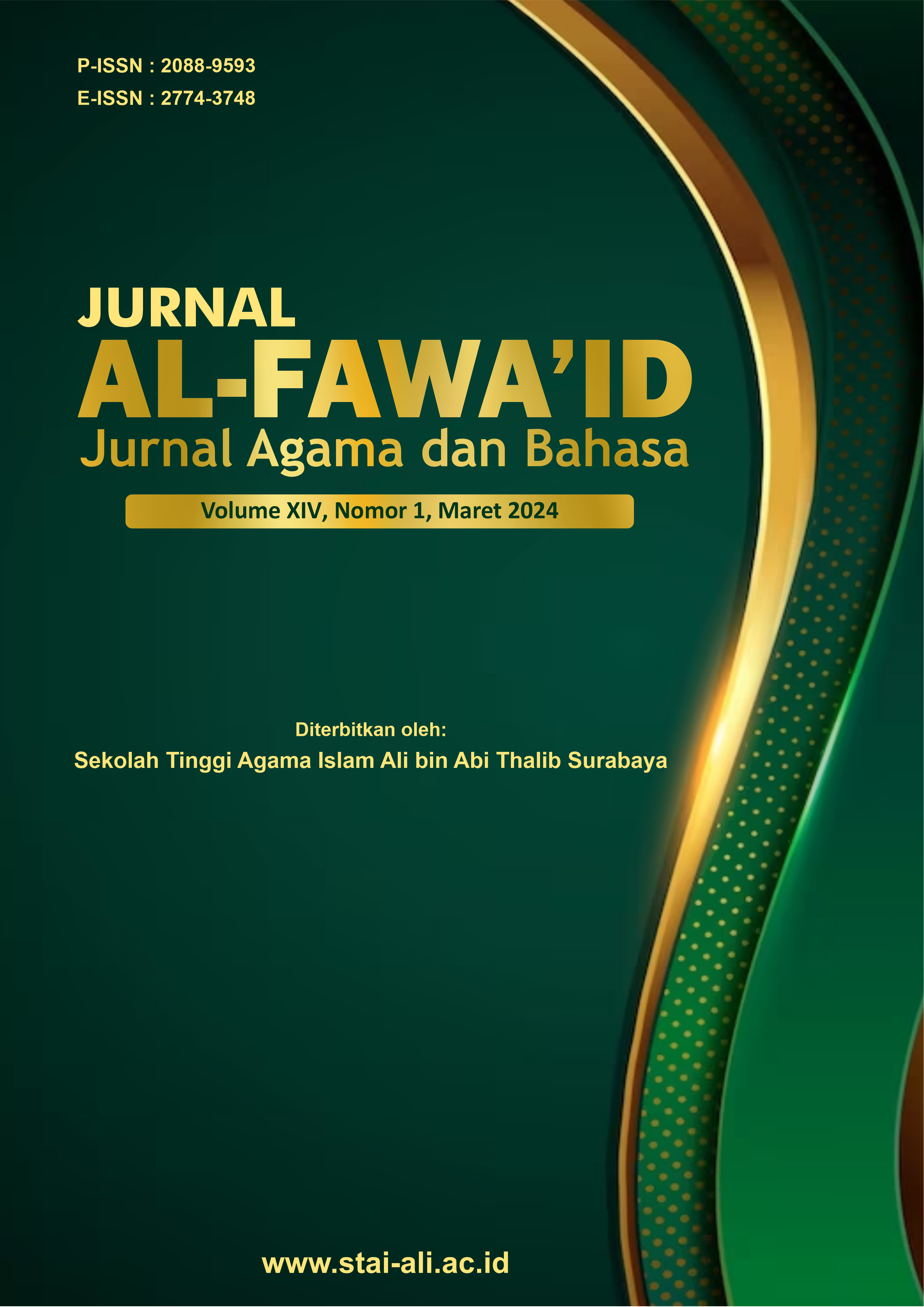Genealogi Manhaj dan Ittijāh Penafsiran al-Shawkāny dalam Kitab Tafsir Fatḥ al-Qadīr
Authors
Oscar Wardhana Windro Saputro
This research is aimed at finding out the genealogy of the manhaj and ittija>h interpretations of al-Shawka>ny in the book of tafsir Fath} al-Qadi>r. Judging from the research location, type of data and research sources, this research has a qualitative research approach with the type of library research. The data sources in this research, apart from the book of interpretations of Fath} al-Qadi>r, are other books by al-Shawka>ny, as well as al-Shawka>ny's biography to get a description of life and the society around him which influenced his thinking and approach. understand the interpretation of the Koran. Al-Shawka>ny is considered a breakthrough with his thoughts which sought to free society from blind fanaticism towards one particular school of thought. After conducting research, it can be concluded that the manhaj and ittija>h interpretations of al-Shawka>ny in the book of tafsir Fath} al-Qadi>r tend to follow the interpretation methods of classical commentators such as al-Qurt}uby, al-Suyut}y, Ibn Kathi >r, al-Baghawy and Ibn Jari>r al-T{abary. The new finding obtained is Manhaj's interpretation of al-Shawka>ny in the book of tafsir Fath} al-Qadi>r, if seen from the source of the interpretation, it uses the tafsir bi al-Iqtira>n method. If we look at the systematics of the explanation, it uses systematic muqa>rin or comparative interpretation. The breadth of interpretation is the It}na>by interpretation method. Meanwhile, according to the target and sequence of the verses, it is the Tah}li>ly method of interpretation. Ittija>h interpretation of al-Shawka>ny in the book of Tafsir Fath} al-Qadi>r, of which there are several styles that dominate apart from Tafsir Lughawy, namely Tafsir Aqady and Tafsir Fiqhy. Even though al-Shawka>ny combines the methods of tafsir bi al-Ma'thu>r and tafsir bi al-Ra'y, the direction of his interpretation tends to be conservative textualist because he adheres strictly to athar, the interpretation of classical commentators and Arabic. The results of this research are useful in determining the classification of al-Shawka>ny's tafsir books as well as providing input for other researchers regarding al-Shawka>ny's thoughts and interpretive manhaj and ittija>h in general.
͑Abbās, F. Ḥassān. (1996). Al-Tafsīr wa al-Mufassirūn Asāsiyyātuh wa Ittijāhātuh wa Manāhijuh fī al-‘Aṣr al-Ḥadīth. Dar al-Nafā’is.
͑Abbās, F. Ḥassān. (2016). Al-Tafsīr wa al-Mufassirūn fī al-‘Aṣr al-Ḥadīth. Dār al-Nafā’is.
Akhdiat, A., & Kholiq, A. (2022). Metode Tafsir Al-Qur’an: Deskripsi Atas Metode Tafsir Ijmali. Jurnal Iman dan Spiritualitas, 2(4), 643–650. https://doi.org/10.15575/jis.v2i4.21315
Al-Anshary, F. M., & Hamzah, A. A. (2022). Telaah Metodologi Penafsiran Imam al-Syaukānī dalam Kitab Tafsir Fatḥ al-Qādir. JOURNAL OF QUR’AN AND HADITH STUDIES, 11(1), 57–86. https://doi.org/10.15408/quhas.v11i1.24246
Arikunto, S. (2006). Prosedur Penelitian ; Suatu Pendekatan Praktek. Rineka Cipta.
Dhahaby (al), M. H. (2000). Al-Tafsīr wa al-Mufassirūn. Maktabah Wahbah.
Fauziah, A. N., & Putri, D. N. (2022). Cara Menganalisis Ragam Sumber Tafsir Al-Qur’an. Jurnal Iman dan Spiritualitas, 2(4), 531–538. https://doi.org/10.15575/jis.v2i4.18741
Ḥalaby (al), N. al-Dīn. (1993). ‘Ulūm al-Qur’ān al-Karīm. Maṭba’ah al-Ṣabāḥ.
Hanafi, Y. (2012). Pemikiran Politik dalam Tafsir Fath Al-Qadir. Jurnal Ilmiah Ilmu Ushuluddin, 11(2).
Ibn Baṭṭah. (2000). Al-Ibānah al-Kubrā. Dār al-Rāyah.
Ihsan, M. (2008). METODOLOGI TAFSIR IMAM AL-SHAWKÂNÎ DALAM KITAB FATH AL-QADÎR: KAJIAN TERHADAP SURAH AL-FÂTIHAH. HUNAFA: Jurnal Studia Islamika, 5(2), 201. https://doi.org/10.24239/jsi.v5i2.168.201-214
Ikhsan, M., & Nurdin, A. (2023). Tafsir bi al-Ma’tsur sebagai Metode dalam Memahami Al-Qur’an. Jurnal Iman dan Spiritualitas, 3(4), 607–614. https://doi.org/10.15575/jis.v3i4.30959
Khālidy (al), Ṣalāh. (1996). Al-Tafsīr wa al-Ta’wīl fī al-Qur’ān. Dar al-Nafā’is.
Moleong, L. J. (2007). Metode Penelitian Kualitatif. Remaja Rosdakarya.
Mukarramah, A. (2015). Fatḥ al-Qadīr Karya Imām al-Syaukānī (Suatu Kajian Metodologi) [Tesis]. UIN Alauddin.
Putra, A. (2018). METODOLOGI TAFSIR. Jurnal Ulunnuha, 7(1), 41–66. https://doi.org/10.15548/ju.v7i1.237
Rahmawati, R., Arifin, S. S., & Yunus, B. M. (2023). Selayang Pandang Tafsir Aqo’idi. Jurnal Iman dan Spiritualitas, 3(4), 595–600. https://doi.org/10.15575/jis.v3i4.30909
Rūmy (al), F. (1986). Ittijāhāt al-Tafsīr fī al-Qarn al-Rābi’ ‘Ashar. Ri’āsah Idārāt al-Buḥūth wa al-Iftā.
Ṣabbāgh (al), M. L. (1990). Lamaḥāt fī ‘Ulūm al-Qur’ān wa Ittijāhāt al-Tafsīr. al-Maktab al-Islamy.
Saputro, O. W. W. (2019). Metode Tafsir Prespektif al-Shawkāniy: (Studi Analisis Kitab Tafsir Fatḥ al-Qadīr). Jurnal Al-Fawa’id : Jurnal Agama dan Bahasa, 9(1), 137–154. https://doi.org/10.54214/alfawaid.Vol9.Iss1.36
Shahry (al), A. M. (1431H). Al-Shāhid al-Shi’ry fī Tafsīr al-Qur’ān al-Karīm. Maktabah Dār al-Minhāj.
Sharqāwy (al), A. M. (1425). Mawqif al-Imām al-Shawkāny fī Tafsīrih min al-Munāsabāt. Jāmi’ah al-Azhar.
Shawkāny (al). (1414H). Fatḥ al-Qadīr al-Jāmi ͗ Bayna Fannay al-Riwāyah wa al-Dirāyah min ‘Ilm al-Tafsīr. Dār al-Kalim al-Ṭayyib.
Shawkāny (al), M. ‘Aliy. (t.t.). Al-Fatḥ al-Rabbāny fī Fatāwā al-Shawkāny. Maktabah al-Jāl al-Jadīd.
Shawkāny (al), M. ‘Aliy. (1396). Al-Qawl al-Mufīd fī Adillah al-Ijtihād wa al-Taqlīd. Dār al-Qalam.
Ṭayyār (al), M. (1423). Fuṣūl fī Uṣūl al-Tafsīr. Dār Ibn al-Jauzy.
Ṭayyār (al), M. (1427). Mafhūm al-Tafsīr wa al-Ta’wīl wa al-Istinbāṭ wa al-Tadabbur wa al-Mufassir. Dār Ibn al-Jauzy.
Ṭayyar (al), M. (1432H). Al-Tafsīr al-Lughawy li al-Qur’ān al-Karīm. Dar Ibn al-Jauzy.
Ṭayyar (al), M. (1427H). Mafhūm al-Tafsīr wa al-ta’wīl wa al-Istinbāṭ wa al-Tadabbur wa al-Mufassir. Dar Ibn al-Jauzy.
Tim Penulis. (2022). Al-Mawsū’ah al-Qur’āniyyah al-Mutakhaṣṣiṣah. al-Majlis al-A’lā li al-Shu’ūn al-Islāmiyyah.
Article Sidebar
Copyright (c) 2024 Oscar Wardhana Windro Saputro

This work is licensed under a Creative Commons Attribution 4.0 International License.

